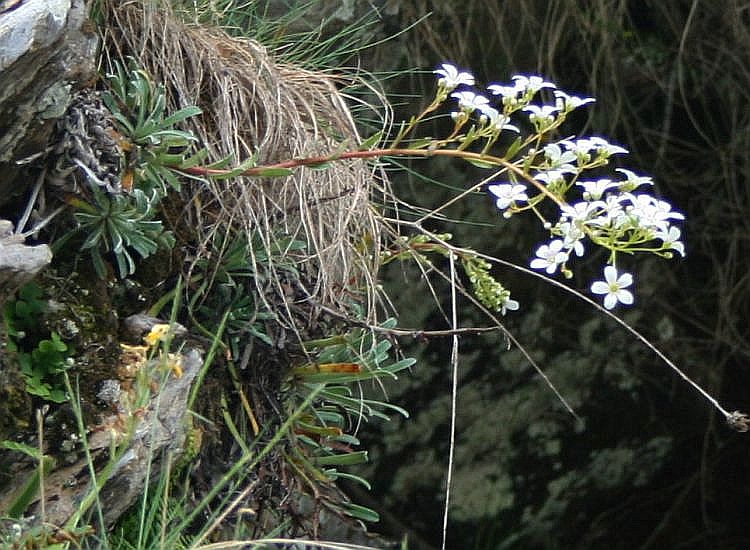Classification System: APG IV
Superregnum: Eukaryota
Regnum: Plantae
Cladus: Angiosperms
Cladus: Eudicots
Cladus: Core eudicots
Ordo: Saxifragales
Familia: Saxifragaceae
Genus: Saxifraga
Subgenus: S. subg. Saxifraga
Sectio: S. sect. Ligulatae
Species: Saxifraga callosa
Subspecies: S. c. subsp. callosa – S. c. subsp. catalaunica
Name
Saxifraga callosa Sm. in Dickson, Coll. Dried Pl. 3: t. 63. 1791.
References
Smith, J.E. in Dickson, J. (1791) Coll. Dried Pl. 3: t. 63.
USDA, ARS, Germplasm Resources Information Network. Saxifraga callosa in the Germplasm Resources Information Network (GRIN), U.S. Department of Agriculture Agricultural Research Service. Accessed: 08-Apr-12.
Saxifraga callosa, the limestone saxifrage, is a species of flowering plant in the family Saxifragaceae, that is native to maritime alpine habitats in Western Europe (Italy, France and Spain). Growing to 50 cm (20 in) tall by 100 cm (39 in) broad, it is a clump-forming evergreen perennial with rosettes of narrow grey-green leaves that are coated in lime. The starry, pure white flowers are borne in long panicles in spring.
The Latin specific epithet callosa means “thick-skinned, with calluses”.[1]
Lower taxa
Saxifraga callosa is a variable species depending on location, Two subspecies and at least two varieties are recognised:-[2]
Saxifraga callosa subsp. callosa
var. australis
var. callosa
Saxifraga callosa subsp. catalaunica
Cultivation
Saxifraga callosa is cultivated as an ornamental garden plant. As it requires well-drained alkaline soil in full sun, it is often grown in an alpine house, where specialist conditions can be provided. It has gained the Royal Horticultural Society’s Award of Garden Merit.[3][4]
References
Harrison, Lorraine (2012). RHS Latin for Gardeners. United Kingdom: Mitchell Beazley. ISBN 184533731X.
"Flora Europaea". Royal Botanic Garden Edinburgh. Retrieved 3 November 2018.
"RHS Plantfinder - Saxifraga callosa". Retrieved 1 November 2018.
"AGM Plants - Ornamental" (PDF). Royal Horticultural Society. July 2017. p. 95. Retrieved 1 November 2018.
Retrieved from "http://en.wikipedia.org/"
All text is available under the terms of the GNU Free Documentation License


